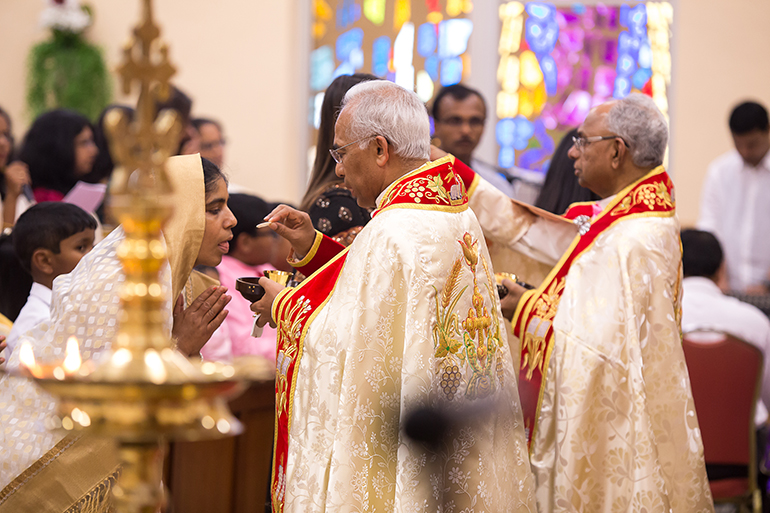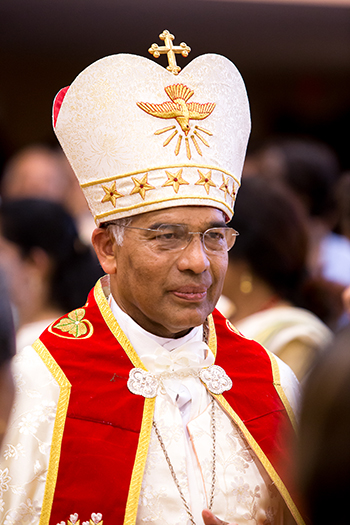By Jim Davis - Florida Catholic

Photographer: TOM TRACY | FC
Mar Mathew Moolakatt, left, of the Archdiocese of Kottayam, India and Mar Jacob Angadiath, Bishop of St. Thomas Syro-Malabar Catholic Diocese of Chicago, distribute Communion at the dedication Mass for the new parish of Jude Knanaya in Fort Lauderdale.
See related story: Blending East and West
FORT LAUDERDALE | The new St. Jude Knanaya Church belongs to one of the oldest Christian communities anywhere — dating, they say, to St. Thomas the Apostle. It belongs to the Syro-Malabar Catholic Church, which counts 4.6 million members worldwide — larger than some American denominations, like the mainline Episcopal and Presbyterian churches.
The Syro-Malabar Church in turn is one of 22 Eastern or Oriental churches, which include the Maronite, Ukrainian, Chaldean and others. They have their own bishops but remain in communion with Rome and the pope.
Tradition says St. Thomas landed in Kerala in the year 52 and founded seven churches. He was martyred two decades later in Chennai, but the communities survived as his spiritual heirs.

Photographer: TOM TRACY | FC
Mar Mathew Moolakatt of the Archdiocese of Kottayam, India was on hand May 31 for the dedication of a new Syro-Malabar parish, St. Jude Knanaya in Fort Lauderdale.
"We are all St. Thomas Christians," said Siju George of St. Jude Knanaya Church, who has studied oral history in Kottayam, India, seat of the Syro-Malabar Church.
But the churches began to lose their Christian identity, George said. In the fourth century a merchant from Mesopotamia named Thomas of Cana came to the Malabar Coast of India. What he saw worried him: Churches were blending Hindu and Christian cultures.
Thomas returned to the Middle East and reported the situation to Uraha Mar Yousef of Uraha, a bishop in the Antiochian Patriarchate. Around the same time, Yousef had a dream in which he heard God say, "Help my children in the East." The two organized a mass emigration of 400 people from 72 families to India, where they formed a church based on the Syriac liturgy.
For the next 12 centuries, the Thomas Christians accepted the rule of bishops from the East Syrian Church, but they retained authority in social and cultural practices through their own synod. So they remained Catholic in religion and Indian in culture.
The arrival of Portuguese explorers in the 16th century led to a split, with one group accepting Roman rule and the other resisting it. After other splits and disputes, the churches of the Malabar Coast gained their own rites and bishops in 1896.
In 1957, Pope Pius XII approved a distinct, eastern-style rite for the church, and Pope John Paul II followed up in 1992 by declaring the Syro-Malabar group a sui juris, autonomous church. Finally, the Vatican in 2004 granted full administrative powers to the Syro-Malabar Church, including the power to elect bishops.
Siju George explains the relationship this way: "I draw a big circle of the Roman Catholic Church. Inside the big circle, I draw a smaller circle for the Syro-Malabar Church. I am a Catholic, but at the same time I am a Syro-Malabar Christian."
The dual Christian-Indian heritage is embodied in the nilavilakku, the brass standing lamp in most Syro-Malabar churches. The lamp depicts a cross standing in a lotus blossom, showing the Christian faith rooted in Indian culture. The ends of the cross have small round growths, a sign that faith is always growing.

